 |
 |
 |
 |
 |
 |
 |
 |
 2000 Shippocho Tohshima 2000 Shippocho Tohshima
 Jusanwari, Ama City, Aichi, Jusanwari, Ama City, Aichi,
 497-0002, JAPAN 497-0002, JAPAN
 +81-52-443-7588 +81-52-443-7588 |
 |
|
 |
 |
 |
To produce cloisonne enamel ware, basically a different artisan is in charge of a specific process.
Even today, there are very few areas which can be mechanized, and all areas of work, including edgeline insertion and glazing, are carried out under the direction of artisans with years of experience. |
|
 |
 |
 |
 |
 |
 |
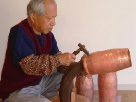 |
 |
Sheets mainly of copper are hammered into the base shape.
Here, "squeeze equipment" using lathe and an iron rod, or "hand pressing" by hammering the copper sheets by hand with tools are carried out. |
 |
 |
 |
 |
 |
 |
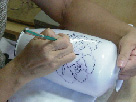 |
 |
| After preparation of the base is completed, an outline of the picture is inked on the surface. There are two ways, directly drawing onto the copper sheet, or drawing after white enamel is applied over the entire surface and then fired. |
 |
 |
 |
 |
 |
 |
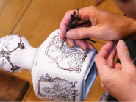 |
 |
| Silver wire is glued over the inked outline on the surface of the vase. The glue is made from the root of the Chinese Ground Orchid (Bletilla striata) that has been dried and finely ground. |
 |
 |
 |
 |
 |
 |
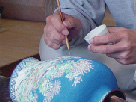 |
 |
| After completing the edgeline insertion, the vase is held in place by the "Uma." Glaze is applied between the raised edgelines. Cloisonne glaze is mainly composed of saltpeter and silica, to which metal oxide is added for color. The glaze is then placed in a melting pot and heated. |
 |
 |
 |
 |
 |
 |
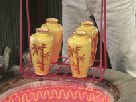 |
 |
| These days, an electric kiln is used. Generally, firing is conducted at 700-800℃ for 10 minutes, but will vary according to type of glaze, as well as shape and size of the product. |
 |
 |
 |
 |
 |
 |
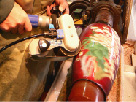 |
 |
| After firing, the glassy shine of the cloisonne surface is brought out. The surface is polished, highlighting the contours of the metal lines of the design. In the past, a whetstone and charcoal from Japanese Bigleaf Magnolia (Magnolia obovata) were used, but today industrial diamonds are used. |
 |
 |
 |
 |
 |
 |
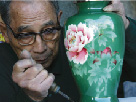 |
 |
| Finally, silver or silver-plated rings are attached to the top and bottom of the vase. |
 |
 |
|
 |
 |
 |
|
 |
|
 |
|